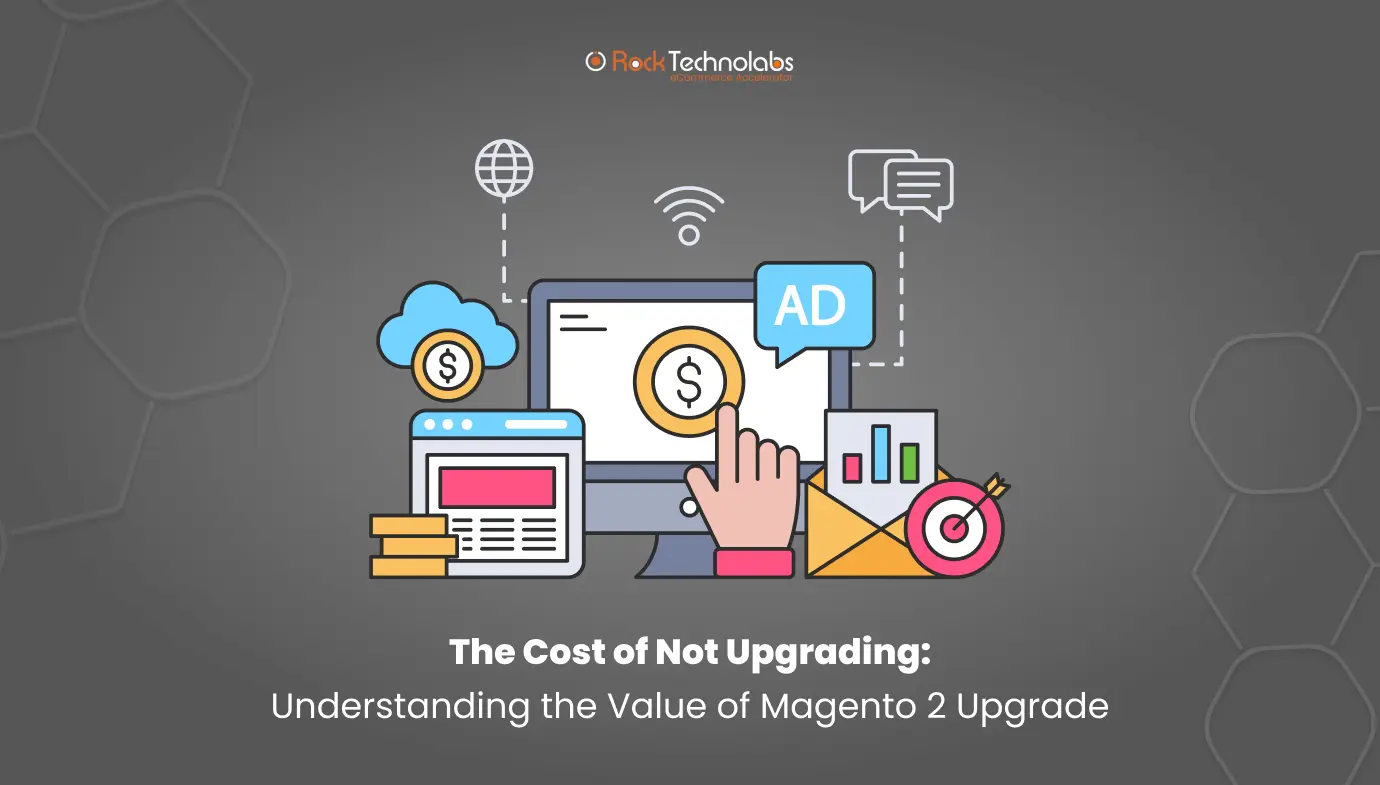The Cost of Not Upgrading: Understanding the Value of Magento 2 Upgrade
Regular updates are a necessity for all software, irrespective of how their capabilities to adapt to the fast-paced tech landscape and the never-ending demand of today’s users. Here, Magento is no exception to the rule of upgradation as it carries a big chunk of the e-commerce market with 90,180 live websites using Magento 2 and an additional 120,266 sites that have used Magento 2 historically in the United States.
To safeguard customers from potential security threats like hacks or spam, Magento’s support teams release upgrades every other month, ensuring the software remains current and secure. Also, at the same time, many hired Magento developers offer Magento 2 upgrade services to improve the site performance and better shopping experiences.
Magento has not just endured over time; it has adapted to meet the challenges of a dynamic market. Besides this, the introduction of Magento 2.4.6 marks not merely an update but an exceptional change for both developers and online customers, with 300+ security fixes and performance enhancements.
However, still, many Magento merchants are sticking to the older version of Magento 2 which is becoming a hindrance in scaling up their online business to new heights. Even till date many stores are missing some of the most advanced functionalities without knowing what losses it incurs to their business. So, in this detailed blog, we will discuss what would be the consequences of not having a Magento upgraded version.
Risk Involve In Not Upgrading Your Magento Store To It’s Latest Version
Compatibility Issues with Third-Party Extensions:
Third-party extensions play a crucial role in Magento’s ecosystem by offering additional features and functionalities to your store, including shipping software, secure payment gateways, inventory management, an automated accounting system, Customer Relationship Management (CRM) System, and so on. However, neglecting to update your Magento store can create compatibility issues with these extensions as they won’t worry properly, will cause errors and conflicts that may affect your website’s performance adversely.
Furthermore, compatibility issues can lead to security vulnerabilities since outdated extensions might not align with the latest security patches that come with the latest version of Magento 2. Updating your Magento store ensures that your extensions remain current and compatible, thus eliminating the risks of errors, conflicts, and security breaches.
Inability to Keep Pace with Industry Trends and Standards:
The e-commerce landscape is constantly mutating at an extremely fast pace, necessitating firms to adapt to stay competitive as there are over 26.5 million active ecommerce websites globally. Failing to upgrade your Magento store can result in falling behind industry trends and standards, placing you at a disadvantage compared to your rivals.
For instance, In 2022, 41.8% of all retail ecommerce sales worldwide came from mobile, indicating the rise in “commerce,” as per the data from Insider Intelligence. Due to which mobile responsiveness is pivotal for e-commerce platforms, and failing to update your store accordingly can result in a subpar user experience for mobile users, potentially driving them away to competitors.
Loss of Customers to Competitors with Modern Stores:
No customer wants to visit a store that takes more time to load, has a poor appearance, and where the features work badly. One of the biggest reasons for increasing bounce rate is not upgrading your Magento store, which ultimately leads to losing customers to competitors who have updated stores with Magento upgraded version.
Today’s consumers want personalized offers, enhanced graphics, easy navigation, and more options for payment and shipping. Including all these, upgrading your Magento store can enhance your website’s design, functionality, and user experience, making it more appealing to customers while giving you an edge in competitiveness.
Revenue Loss from Site Downtime and Suboptimal User Experience:
On average, businesses have lost $756 billion in potential revenue because of poor e-commerce personalization experiences and lack of other necessary functionalities. That’s why another financial risk associated with neglecting to update your Magento store is revenue loss due to site downtime and suboptimal user experience.
As previously mentioned, failing to update your store can result in slow loading times, downtime, and a poor user experience, ultimately leading to abandoned carts and revenue loss.
The financial impact of revenue loss can be significant, especially for businesses with high traffic and transaction volumes. Here Magento 2 upgrade services can enhance your website’s performance and user experience, thereby minimizing the risk of revenue loss due to site downtime and poor user experience.
Outdated Features and Functionalities:
Suppose you land on a clothing ecommerce store and there is no option to add a product to your wishlist or have no option to see a similar product. Would you like to stay there or prefer to visit another feature-rich site? This is how neglecting to update your Magento store puts you at a disadvantage compared to competitors. As the e-commerce industry introduces new features and functionalities, failing to keep pace and sticking to the old-age features may result in losing customers to competitors with more modern and up-to-date stores.
Subpar User Experience and Cart Abandonment:
Another performance risk associated with neglecting to update your Magento store’s cart abandonment rate, which stands at around 70% of online shopping carts everywhere. Not taking advantage of Magento 2 upgrade services, and outdated websites often appear unprofessional and may be challenging to navigate, resulting in a poor user experience that drives users away, abandoning their carts in the process.
Cart abandonment can lead to revenue loss, and a suboptimal user experience can tarnish your brand’s reputation. Updating your Magento store can enhance your website’s design, navigation, and user experience, reducing the risk of cart abandonment and improving customer engagement and retention.
Benefits Of Upgrading To The Latest Version Of Magento 2
Accessing New Features:
From time to time, Magento unveils a plethora of exciting features and functionalities, including product browsing features, marketing, promotion, & conversion tools, product comparison with history, saved shopping cart, and so on that enrich your store’s capabilities, fostering customer engagement, and refining marketing strategies. By not implementing Magento’s upgraded version or opting for Magento 2 upgrade services, you forfeit the opportunity to harness these enhancements, potentially lagging behind competitors.
Support and Community Engagement:
Magento extends support and active community involvement to users of its latest versions. Remaining on an outdated iteration may restrict your access to support services and deprive you of invaluable insights and contributions from the vibrant Magento community.
Adherence to Industry Standards:
Operating on an outdated Magento version poses the risk of non-compliance with industry standards such as GDPR or PCI DSS. Compliance is paramount for safeguarding customer data and nurturing trust with your audience.
Rectification of Bugs and Enhancement of Stability:
Upgrading Magento ensures the rectification of bugs and bolstering of stability within your store. Continuing with an obsolete version could precipitate unforeseen issues, downtime, and customer dissatisfaction.
Preventing the Spread of Malware and Hacking Threats:
Older versions of Magento, like Magento 1 or Magento 2.2, 2.4, and others, are more susceptible to malware and hacking attempts. Hackers often exploit known vulnerabilities in older software versions through server attacks, website defacement, botnetting, cross-site scripting, and other methods.
Upgrading to the latest Magento version can fortify your defenses against such attacks by addressing known vulnerabilities and implementing advanced security features such as two-factor authentication, strong protection from hosting, recaptcha, security audit, and other security scans.
Conclusion
Remember, the new Magento upgrade version empowers merchants to maintain a flawless shopping journey, cultivate customer confidence, and position their enterprises for sustained expansion and prosperity, however not going through the upgrade will surely result in adverse consequences.
Procrastinating upgrades carry grave repercussions, from exposing security loopholes to forfeiting potential business advancements. Hired Magento developers or experienced Magento 2 upgrade service providers assist merchants to prioritize and meticulously strategize timely upgrades to uphold your online platforms’ optimal performance and fortify your enterprises for the future.



